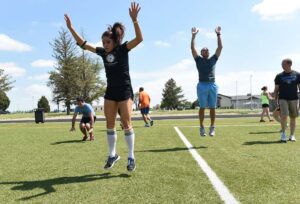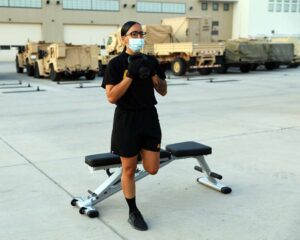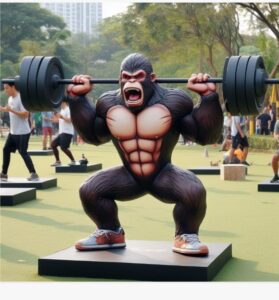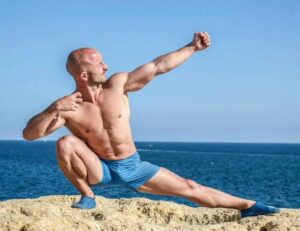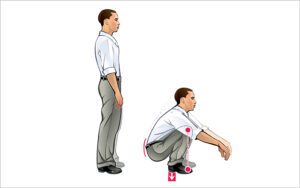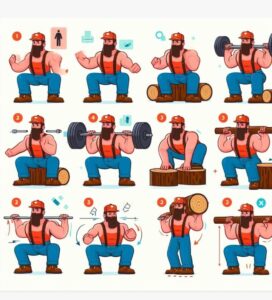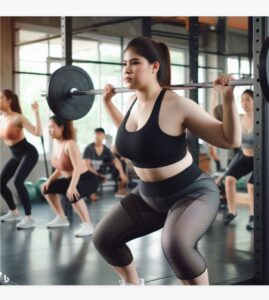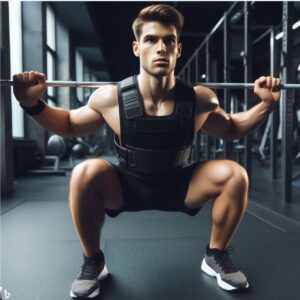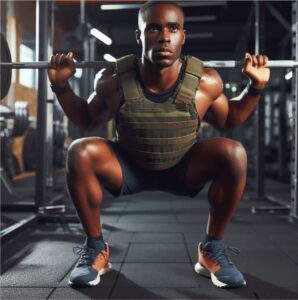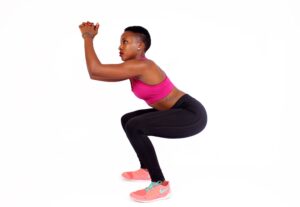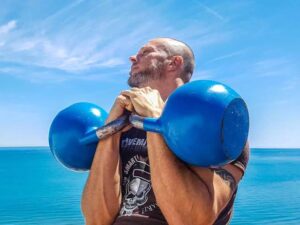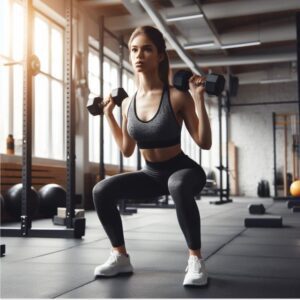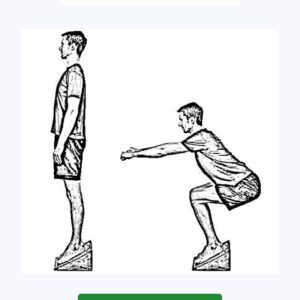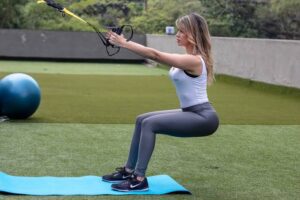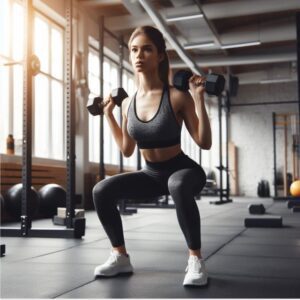
When it comes to lower body exercises, the Jefferson squat stands out as a unique and effective movement that engages multiple muscle groups simultaneously.
This exercise, named after the legendary strongman Charles Jefferson, offers a range of benefits that can enhance your strength, stability, and overall fitness.
In this article, we will delve into the 12 key benefits of Jefferson squats and explore how this exercise provides such impressive results.
Benefits of Jefferson Squats
Jefferson squats offer a wide range of benefits for all individual of different fitness levels. Here are 12 Jefferson squat benefits you should know about:
1. Full Body Activation
Jefferson squats are a compound exercise that targets multiple muscle groups in the lower body, including the quadriceps, hamstrings, glutes, and calves.
Additionally, due to the unique positioning of the feet, the adductors and abductors of the inner and outer thighs are also engaged. This comprehensive muscle activation leads to greater overall strength and stability.
2. Enhanced Quadriceps Development
The quadriceps, located at the front of the thigh, play a vital role in knee extension and overall lower body strength.
Jefferson squats place a significant load on the quadriceps, making them an excellent exercise for building and sculpting these muscles.
The deep range of motion and the positioning of the feet during the exercise specifically target the quadriceps, helping to develop strong and defined thighs.
3. Powerful Hamstring Engagement
The hamstrings, located at the back of the thigh, are responsible for knee flexion and hip extension.
Jefferson squats require a controlled eccentric (lowering) phase, which places a significant load on the hamstrings.
This engagement leads to improved hamstring strength, stability, and flexibility.
4. Glute Activation and Development
Strong glutes are essential for overall lower body strength, stability, and aesthetics. Jefferson squats effectively target the gluteal muscles, including the gluteus maximus, medius, and minimus.
The deep squatting motion and the wide stance activate these muscles, promoting their development and enhancing overall hip power.
5. Improved Hip Mobility
Jefferson squats require a wide stance with one foot positioned in front of the other.
This unique positioning challenges hip mobility and flexibility, particularly in the hip adductors and abductors.
Performing this exercise regularly can help improve hip mobility, reduce tightness in these muscles, and enhance overall range of motion.
6. Increased Core Stability
Maintaining proper form during Jefferson squats requires significant core engagement.
The core muscles, including the abdominals, obliques, and lower back, work together to stabilize the spine and pelvis during the exercise.
This increased core stability not only enhances your performance in the squat but also carries over to other functional movements.
7. Improved Balance and Coordination
Jefferson squats require a balanced and coordinated movement pattern, as you are performing the exercise with one foot in front of the other.
This unique stance challenges your balance and proprioception, which are essential for overall stability and injury prevention.
Regular practice of Jefferson squats can improve your balance and coordination, leading to better performance in various sports and activities.
8. Strengthened Ankles and Lower Legs

The unique positioning of the feet during Jefferson squats places a significant load on the ankles and lower legs.
This helps to strengthen the muscles, tendons, and ligaments in these areas, providing greater stability and reducing the risk of ankle sprains or other lower leg injuries.
9. Increased Caloric Expenditure
Jefferson squats are a compound movement that engages multiple large muscle groups. As a result, this exercise requires a significant amount of energy, leading to increased caloric expenditure.
Incorporating Jefferson squats into your workout routine can help support weight loss or maintenance goals.
10. Functional Strength and Transferability
Jefferson squats closely mimic movements used in daily activities and sports. The squatting motion and the engagement of various muscle groups make this exercise highly functional.
The strength and stability gained from Jefferson squats can be transferred to real-life movements, such as lifting heavy objects, climbing stairs, or participating in sports that involve jumping or running.
11. Injury Prevention and Rehabilitation
By engaging multiple muscle groups and promoting overall strength and stability, Jefferson squats can help prevent injuries in the lower body.
Additionally, this exercise can be used in rehabilitation programs to improve muscle imbalances, strengthen weak areas, and restore proper movement patterns.
12. Versatility and Adaptability
Jefferson squats can be performed with different equipment, such as barbells, dumbbells, kettlebells, or even bodyweight.
This versatility allows for various progressions and modifications to suit different fitness levels and goals. Whether you are a beginner or an experienced athlete, Jefferson squats can be tailored to your specific needs.
In summary: Jefferson squats deliver a dynamic, full-body workout that enhances muscle development, promotes improved hip mobility, strengthened ankles, increased core stability and It contributes to better balance, coordination, and calorie expenditure. With functional strength and transferability to daily activities, Jefferson squats aid in injury prevention and rehabilitation. Their versatility, adaptable to different equipment and fitness levels, makes them an efficient choice for comprehensive fitness goals.
Optimizing Jefferson Squats Benefits
Jefferson squats are a versatile exercise that targets multiple muscle groups, including the quadriceps, hamstrings, glutes, and core.
They can be a valuable addition to your workout routine, helping to improve lower body strength, stability, and overall athleticism. In this section, we will discuss how to optimize the benefits of Jefferson squats and provide guidance on performing them with proper form.
To make the most of your Jefferson squats and optimize their benefits, consider the following tips:
- Focus on Form: Proper form is crucial for maximizing the effectiveness of any exercise. Pay attention to your posture and alignment throughout the movement. Keep your chest up, shoulders back, and core engaged. Avoid rounding your back or letting your knees cave in.
- Warm Up: Before performing Jefferson squats, it’s essential to warm up your body with dynamic stretching and mobility exercises. This helps increase blood flow to the muscles, improves flexibility, and reduces the risk of injury.
- Gradually Increase Weight: Jefferson squats can be performed with a barbell, dumbbells, or kettlebells. Start with a weight that challenges you without compromising your form. As you progress, gradually increase the weight to continue challenging your muscles.
- Incorporate Variations: To target different muscle groups and add variety to your workouts, consider incorporating variations of the Jefferson squat. For example, you can perform single-leg Jefferson squats or add a pulse at the bottom of the movement to increase the intensity.
- Use Proper Breathing Techniques: Breathing properly during Jefferson squats can enhance your performance and help stabilize your core. Inhale deeply before descending into the squat and exhale forcefully as you drive back up to the starting position.
Proper Form for Jefferson Squats
Follow these steps to perform Jefferson squats with proper form:
- Start by standing with your feet wider than shoulder-width apart, toes pointed slightly outward.
- Hold a barbell, dumbbell, or kettlebell with both hands, gripping it in the center and allowing it to hang between your legs.
- Brace your core, keep your chest up, and maintain a neutral spine throughout the movement.
- Begin the squat by bending your knees and lowering your hips down and back, as if sitting into a chair. Keep your weight evenly distributed between both feet.
- Descend until your thighs are parallel to the ground or slightly below, ensuring that your knees track in line with your toes.
- Drive through your heels, engage your glutes, and extend your hips and knees to return to the starting position.
- Repeat for the desired number of repetitions.
It is crucial to start with lighter weights and focus on mastering the proper form before progressing to heavier loads. If you’re unsure about your form, consider working with a qualified fitness professional who can provide guidance and ensure you’re performing the exercise correctly.
Jefferson squats can be a valuable addition to your lower body workout routine. By optimizing the benefits of Jefferson squats through proper form, gradual progression, and incorporating variations, you can enhance your lower body strength, stability, and overall athletic performance.
Prioritize proper form, warm up adequately, and listen to your body to avoid injury and maximize your results.
So, why not give Jefferson squats a try and not only enjoy it benefits but also experience the power of this unique exercise for yourself?
Related Posts
[1] https://powerliftingtechnique.com/jefferson-squat/
[2] https://barbend.com/jefferson-squat/
[3] https://www.boxrox.com/jefferson-squat-muscles-worked-benefits-technique/
[4] https://swolverine.com/blogs/blog/jefferson-squat
[5] https://strongshop.com.ua/en/powertraining/strength-exercises/leg-workout/263-jefferson-squat
[6] https://www.masterclass.com/articles/jefferson-squat-guide
